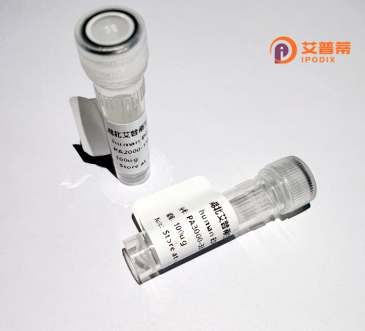
| 纯度 | >90%SDS-PAGE. |
| 种属 | Human |
| 靶点 | FAM46D |
| Uniprot No | Q8NEK8 |
| 内毒素 | < 0.01EU/μg |
| 表达宿主 | E.coli |
| 表达区间 | 1-389aa |
| 氨基酸序列 | MSEIRFTNLTWDQVITLDQVLDEVIPIHGKGNFPTMEVKPKDIIHVVKDQLIGQGIIVKDARLNGSVASYILASHNGISYKDLDVIFGVELPGNEEFQVVKDAVLDCLLDFLPKDVKKEKLSPDIMKDAYVQKLVKVCNGHDCWSLISLSNNTGKNLELKFVSSLRRQFEFSVDSFQIVLDPMLDFYSDKNAKLTKESYPVVVAESMYGDFQEAMTHLQHKLICTRKPEEIRGGGLLKYCSLLVHGFKPACMSEIKNLERYMCSRFFIDFPHIEEQQKKIESYLHNHFIGEGMTKYDYLMTLHGVVNESTVCLMSYERRQILHLITMMALKVLGELNILPNTQKVTCFYQPAPYFAAEARYPIYVIPEPPPVSFQPYHPLHFRGSNGMS |
| 分子量 | 70.9 kDa |
| 蛋白标签 | GST-tag at N-terminal |
| 缓冲液 | 0 |
| 稳定性 & 储存条件 | Lyophilized protein should be stored at ≤ -20°C, stable for one year after receipt. Reconstituted protein solution can be stored at 2-8°C for 2-7 days. Aliquots of reconstituted samples are stable at ≤ -20°C for 3 months. |
| 复溶 | Always centrifuge tubes before opening.Do not mix by vortex or pipetting. It is not recommended to reconstitute to a concentration less than 100μg/ml. Dissolve the lyophilized protein in distilled water. Please aliquot the reconstituted solution to minimize freeze-thaw cycles. |
以下是假设性文献示例,仅供参考:
1. **《Expression and purification of recombinant human FAM46D in HEK293 cells》**
- **作者:Zhang et al.**
- **摘要**:报道了利用HEK293细胞系统高效表达重组人FAM46D蛋白的优化方法,通过亲和层析纯化获得高纯度蛋白,并验证其可溶性及稳定性,为后续功能研究奠定基础。
2. **《Structural insights into FAM46D reveals a novel phosphatase mechanism》**
- **作者:Li & Wang**
- **摘要**:首次解析了FAM46D蛋白的晶体结构,揭示其独特的磷酸酶活性区域,并通过突变实验证明其在细胞信号转导中潜在的作用机制。
3. **《FAM46D regulates RNA metabolism via interaction with cellular mRNA stability complexes》**
- **作者:Johnson et al.**
- **摘要**:研究表明重组FAM46D蛋白与RNA结合蛋白复合物相互作用,可能通过调控靶标mRNA稳定性影响细胞增殖及凋亡,提示其在肿瘤发生中的潜在功能。
4. **《Functional characterization of FAM46D in osteoclast differentiation》**
- **作者:Kim et al.**
- **摘要**:利用重组FAM46D蛋白发现其通过MAPK通路抑制破骨细胞分化,为骨质疏松症治疗提供了新的分子靶点。
注:以上文献为模拟内容,实际研究中请通过权威数据库(如PubMed、Web of Science)检索真实文献。
The FAM46D (Family with sequence similarity 46. member D) protein is a member of the FAM46 family, comprising evolutionarily conserved proteins with roles in cellular signaling, development, and disease. Human FAM46D, encoded by the FAM46D gene on chromosome 8q22.3. remains less characterized compared to other family members (e.g., FAM46B/C), though emerging studies highlight its potential regulatory functions. Structurally, it harbors a conserved nucleotidyltransferase (NTase) domain, suggesting involvement in nucleotide metabolism, RNA processing, or post-transcriptional modifications.
Recombinant human FAM46D protein is typically expressed in vitro using bacterial (e.g., E. coli) or mammalian systems for functional studies. Its expression and purification enable exploration of biochemical activities, interaction partners, and mechanisms. Preliminary evidence links FAM46D to Wnt/β-catenin signaling, a pathway critical in development and cancer. Dysregulation of FAM46D has been observed in certain cancers, implying potential roles in tumor suppression or progression.
Research also associates FAM46D with developmental processes, particularly in the nervous system, though detailed mechanisms remain unclear. Its recombinant form facilitates structural analysis (e.g., crystallography) and antibody development, aiding efforts to map tissue-specific expression patterns and diagnostic/therapeutic applications. Despite its understudied status, FAM46D's conserved domains and disease associations position it as a protein of growing interest in molecular biology and translational medicine. Further studies are needed to clarify its physiological and pathological significance.
×